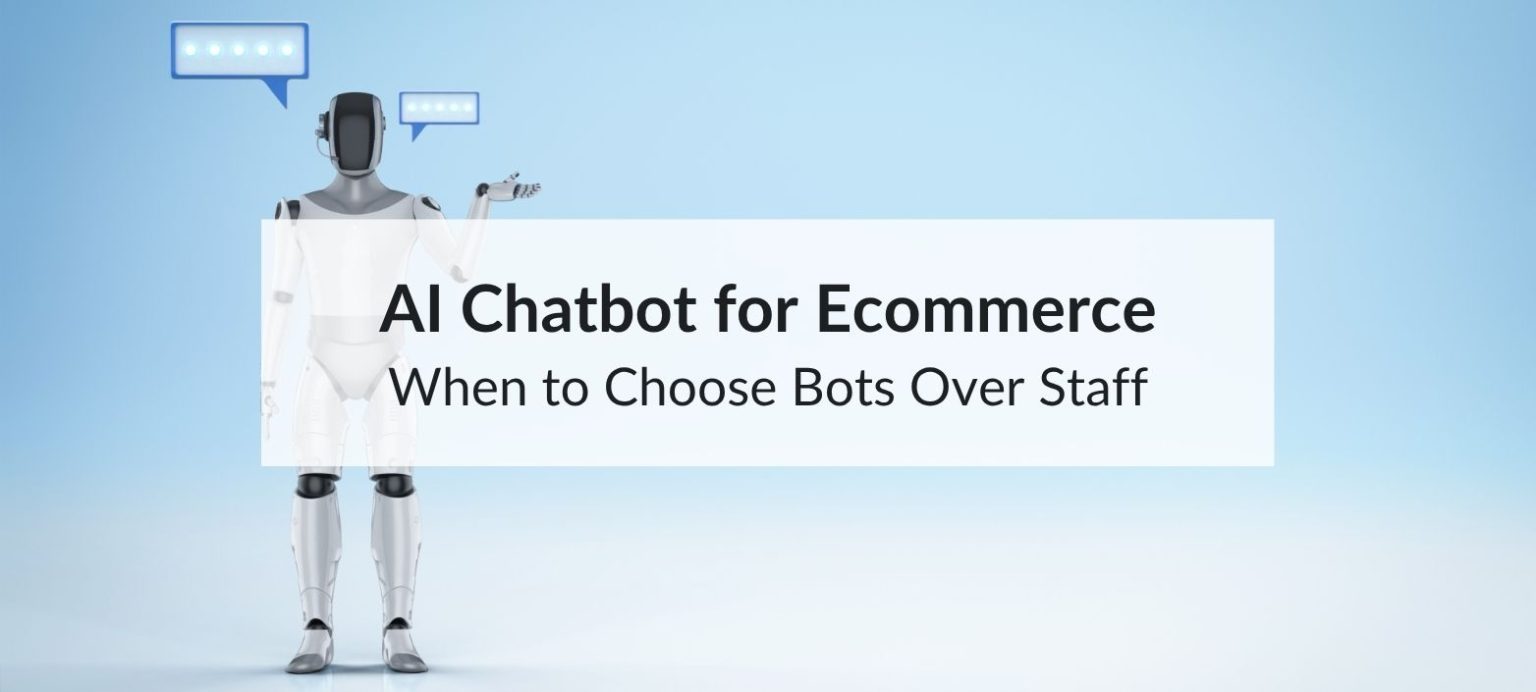As your ecommerce business grows, so does the volume of customer inquiries. Questions about orders, product availability, returns, and delivery times can pile up quickly. Hiring more staff might seem like the next step, but there is another solution worth considering. Implementing an AI chatbot for ecommerce helps you handle repetitive questions, reduce wait times, and improve efficiency.
In this article, we will explore when using an AI chatbot makes more sense than adding staff, how it benefits ecommerce operations, and what tools can help you get started effectively.
What an AI Chatbot for Ecommerce Can Do

Modern AI chatbots offer far more than automated replies. They are designed to assist with core support and sales functions while integrating smoothly with ecommerce platforms.
Common Use Cases for Ecommerce Chatbots
- Answering frequently asked questions (e.g. delivery times, stock availability)
- Tracking orders and managing returns
- Recommending products based on customer preferences
- Guiding customers through checkout
- Providing support after business hours
- Capturing leads for future marketing
When to Use a Chatbot Instead of Hiring More Staff
Choosing between automation and hiring comes down to evaluating time, cost, and scalability. Here are a few scenarios where an AI chatbot for ecommerce is the better option.
1. Your Team Repeats the Same Answers Daily
If your agents spend most of their time answering basic questions such as “What’s your return policy?” or “Is this product available in medium?”, then you are not using their time effectively. A chatbot can manage these queries instantly and consistently.
2. Your Business is Scaling Faster Than Your Support Team
As order volume increases, support demands grow. Hiring and training take time and resources. Chatbots can be deployed quickly, helping you manage the extra workload without sacrificing response times.
3. You Need 24/7 Support Without a Night Shift
Customers expect immediate answers, regardless of the time of day. AI chatbots are available around the clock, helping maintain customer satisfaction during off-hours, holidays, and peak sales periods.
According to Salesforce, 62% of consumers prefer interacting with a chatbot over waiting for a human response.
Practical Tools and Tips for Using Chatbots in Ecommerce
You do not need a complex system to get started. Today’s chatbot platforms offer simple integrations and powerful features that align with your ecommerce needs.
Select the Right Platform for Your Ecommerce Stack
Choose a chatbot that integrates with your current platform, such as Shopify, WooCommerce, Magento, or a custom build. Popular options include:
- ChatGPT-based bots: Custom AI chatbots tailored to your product and support flow
- Tidio: Live chat and chatbot hybrid, great for Shopify
- Gorgias: Designed for ecommerce support teams
Prioritize Key Functions First
Focus the chatbot on solving high-frequency questions. Common examples include:
- “Where is my order?”
- “What is your return policy?”
- “Do you offer express delivery?”
Once these functions are in place, you can expand the chatbot’s capabilities to include product suggestions, discount code support, and customer account lookups.
Keep Your Chatbot Aligned With Your Brand and Data
Ensure the chatbot provides accurate answers by connecting it with your product database, order management system, and knowledge base. Regular updates and clear scripts help it sound consistent with your brand’s tone while delivering useful answers.
Common Mistakes to Avoid

Automation works best when it is properly managed. Avoid these missteps when implementing an AI chatbot for ecommerce.
1. Relying on Old Scripts or Incomplete Information
If your policies change or you introduce new services, make sure your chatbot reflects those updates. Outdated responses can frustrate customers and create unnecessary support tickets.
2. Attempting to Automate Every Interaction
Some situations require a human response, particularly complex orders, complaints, or issues involving sensitive customer data. Use the chatbot to triage requests, but allow for smooth handoffs to your support team when needed.
3. Ignoring Analytics
Most chatbot platforms provide data on performance, unanswered questions, and customer sentiment. Use this information to improve both your bot’s performance and your overall support process.
Frequently Asked Questions
Q1. How much does an AI chatbot cost?
Many chatbot platforms offer monthly plans starting from around £30 to £300 or more, depending on features, integrations, and usage volume. This is often significantly more affordable than hiring and training additional support staff.
Q2. Can a chatbot increase conversions?
Yes. AI chatbots can guide customers toward products, provide quick answers during decision-making, and assist with checkout issues. All of these factors help reduce drop-offs and improve conversion rates.
Q3. Is chatbot setup complicated?
Not necessarily. Platforms like Tidio or Gorgias are designed for easy setup and work well with most popular ecommerce platforms. For more advanced functionality, many tools offer built-in configuration guides, templates, and integrations that streamline the process, even for users without a technical background.
Q4. Is customer data secure?
Most reputable chatbot platforms follow industry-standard security protocols, including data encryption and GDPR compliance. Always verify your provider’s data privacy and storage policies before implementation to ensure customer trust and legal compliance.
Final Thoughts: Is an AI Chatbot Right for Your Ecommerce Store?
Choosing between an AI chatbot and new staff depends on your business goals, customer expectations, and growth plans. In many cases, an AI chatbot for ecommerce is the most cost-effective way to maintain high-quality service, especially when dealing with repetitive tasks, high volumes, or extended hours.

